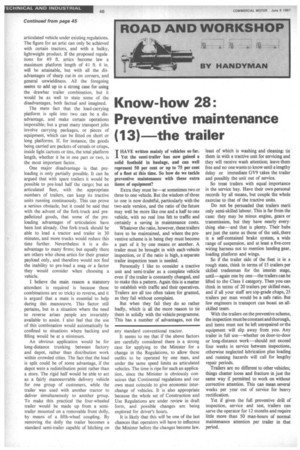Know-how 28: Preventive maintenance (13) the trailer
Page 48

If you've noticed an error in this article please click here to report it so we can fix it.
T HAVE written mainly of vehicles so far. 1 Yet the semi-trailer has now gained a solid foothold in haulage, and can well represent 50 per cent or up to 75 per cent of a fleet at this time. So bow do we tackle preventive maintenance with these extra items of equipment?
Extra they must be—at sometimes two or three to one vehicle. But the wisdom of three to one is now doubtful, particularly with the two-axle version, and the ratio of the future may well be more like one and a half to one vehicle, with no real loss felt to traffic and certainly a saving in maintenance costs.
Whatever the ratio, however, these trailers have to be maintained, and where the preventive scheme is in being they must become a part of it by one means or another. A trailer must be brought in with each vehicle inspection, or if the ratio is high, a separate trailer inspection team is needed.
Personally I like to consider a tractive unit and semi-trailer as a complete vehicle even if the trailer is constantly changed, and to make this a pattern. Again this is a matter to establish with traffic and their operatives. Trailers are all too often taken for granted, as they fail without complaint.
But when they fail they do so rather badly, which is all the more reason to tie them in solidly with the vehicle programme. This has a number of advantages, not the
least of which is washing and cleaning: tie. them in with a tractive unit for servicing and they will receive wash attention; leave them free and no one wants to know until a lengthy delay or immediate GV9 takes the trailer and possibly the unit out of service.
So treat trailers with equal importance in the service bay. Have their own personal records by all means, but couple the whole exercise to that of the tractive units.
Do not be persuaded that trailers merit only semi-skilled labour. This is far from the case: they may be minus engine, gears or transmission, but they have nearly everything else—and that is plenty. Their hubs are just the same as those of the unit,there is a self-contained brake system, a wide range of suspension, and at least a five-core wiring harness not to mention landing gear, loading platform and wings.
So if the trailer side of the fleet is in a rough state, think in terms of 15 trailers per skilled tradesman for the interim stage, until—again one by one—the trailers can be lifted to the Class I category. Then you can think in terms of 20 trailers per skilled man, and if all your staff are top-grade chaps, 25 trailers per man would be a safe ratio. But few engineers in transport can boast an allskilled team.
With the trailers on the preventive scheme, the inspection must be constant and thorough, and items must not be left unrepaired or the equipment will slip away from you. Any trailer in full use—whether on door-to-door or long-distance work—should not exceed four weeks in service between inspections, otherwise neglected lubrication plus loading and running hazards will call for lengthy repair periods.
Trailers are no different to other vehicles; things chatter loose and fracture in just the same way if permitted to work on without corrective attention. This can mean several weeks per year out of service for heavy rectification.
Yet if given the full preventive drill of inspection, service and test, trailers can serve the operator for 12 months and require little more than 50 man-hours of normal maintenance attention per trailer in that period.




























































































































